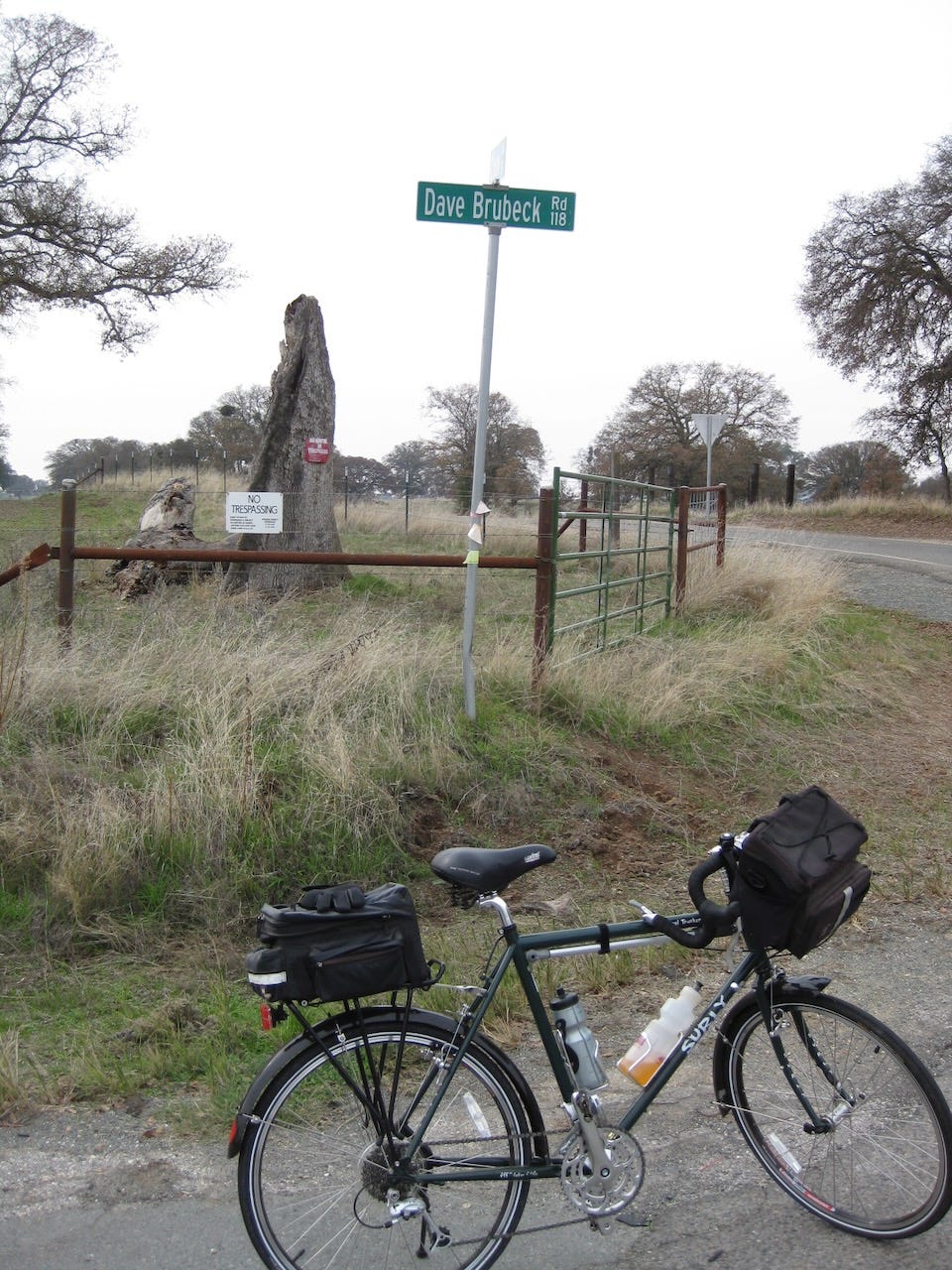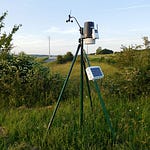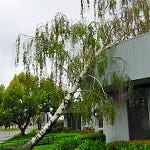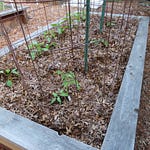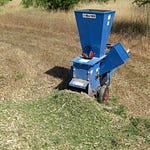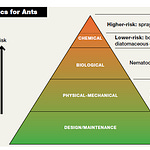Jumping worms, and the publicity about them, are spreading. Debbie Flower (America’s Favorite Retired College Horticulture Professor) and I talked about this in August of 2021 in Episode 126 of the Garden Basics with Farmer Fred podcast. We provided an update on Episode 217 in August of 2022 (listen to that chat in today’s newsletter podcast).

Jumping worms have been in the United States for more than a half century. And they’re moving around the country, with our unknowing help.
As Debbie pointed out in the podcast (above), one of the biggest threats is their poop. Because they tend to reside near the surface and move horizontally through the mulch layer, their poop is more highly mineralized and not incorporated deeper into the soil. Plus, that poop tends to be hydrophobic: it repels water. As a result, the soil fungi and bacteria that would be incorporating typical castings into forms of nutrients for plant availability isn’t happening. The biggest threat is to emerging native plants that would use the nutrients and moisture normally in the soil to germinate, either as understory plants in the forest, or freestanding wildflowers in pastures or prairies.
Verified, effective controls at this point, are still being studied. From Cornell University, come this:
“Research is currently being conducted on invasive worms at the University of Wisconsin and several practices do show some promise of control. Abrasive materials such as biochar (ground up charcoal) and diatomaceous earth (fossilized diatoms) may show some promise in killing adult jumping worms. Incorporate one of these products into the infested soil to a depth where the worms are located; worms that come in contact with the materials will be adversely affected.”
Again, that is ongoing research. Debbie and I, in the newsletter podcast, suggest other possible control measures, including using mustard to bring them to the surface, identify them as jumping worms, and discard them (the recipe is in the podcast).
Oh, you don’t want to listen? OK, here’s the transcript, which can also be found in Episode 217 of the Garden Basics podcast:
Sarah in Sacramento
Hi, Fred and Debbie. This is Sarah from Sacramento. My question is about jumping worms. I've heard they're very destructive. And unfortunately, I recently found three in my yard. So I'd like to know a little more about them. My question has three parts. First, how much of a concern are these worms for the home gardener? And second, is there anything I could or should be doing about the jumping worms? Should I kill the worms when I find them, or just leave them be? And third, I keep reading that their castings deplete the soil? I'm wondering if that's actually true. And if so, why are these worms so different from other types of worms which are generally good for the soil? I have heard the jumping worms eat organic matter really quickly. So could I offset this by simply adding a lot more mulch? Any other advice for me? Thank you so much.
Farmer Fred
Jumping worms. Yes, indeed. We've tackled this topic before here on the garden basics podcast, but the jumping worms are jumping all over the place. Debbie Flower is here, America's favorite retired college horticultural professor, and golly now we have them in our own backyard, Debbie.
Debbie Flower
Yeah, that's unfortunate. Right.
Farmer Fred
And one of the primary ways they spread is through fishing bait. If you go to a bait shop, you may see see worms intended for fishing, and they go by a variety of names, like jumping worm or Asian jumping worm or crazy worms or Alabama jumpers, or snake worms. Don't buy them. And if you do buy them and you have bait left over at the end of your little trip, get rid of them, put them in the trash. Yes, jumping worms, as the caller said, they kind of destroy organic matter because they have a rather big mouthpiece.
Debbie Flower
And super, super, super fast. And that's the problem. Regular earthworms that we're used to and maybe keep in our house to consume our kitchen waste also consume organic matter, but they do it much more slowly. And when the jumping worms consume all the organic matter on the surface of the soil, especially in forests or places around lakes or natural areas, then the there is no organic matter on the surface of the soil that allows other plants, typically their native plants, in those situations, to establish and grow. And so it's causing fast destruction of the mulch layer and is causing destruction of the native plants.
Farmer Fred
And they live very shallowly. Unlike earthworms that tend to go vertically, the jumping worms tend to live horizontally.
Debbie Flower
yes, just below the mulch layer and on top of the soil, that's one way to identify them. If you find a worm there, along with their, their poop, their feces, their black and crumbled, it looks like coffee almost, then that's probably a jumping worm. They're also recognizable because they do jump. And they have a white collar that goes all the way around one end, close to one end of the worm itself, much like a Nightcrawler, which is also used as bait. It has a collar. But in the Nightcrawler, it's kind of a pinkish color. And in the jumping worm, it's a white color, and it is smooth, it doesn't have any ridges in it.
Farmer Fred
It's interesting how it's spread rather quickly, it was first reported back in around 1950, 1960, in the United States, it started off in the east, jumped over to the central states. And that's where it has changed the soil composition there in areas where it is living, its soil composition changes so that the soil is more water resistant, actually,
Debbie Flower
Yeah, the soil becomes more mineral, because they're not bringing the organic matter into the soil like an earthworm would do. They leave it on the surface. And they've already broken it all the way down, the mineral component of soil becomes greater, but an ideal soil will have 45% mineral and then about 5% organic. That 5% doesn't sound like much, but it makes a huge difference in the quality of the soil.
Farmer Fred
The soil gets so crumbly, that it does improve water percolation, but way too much.
Debbie Flower
Yeah, that's the problem there.
Farmer Fred
And it's basically not helping your plants out, because it's destroying that matter before the microbes in the soil have a chance to work it.
Debbie Flower
Right, it's not bringing it down into the soil. The healthy soil has a poop loop. And the bigger things that we can see, like worms, first eat the organic matter, they get what they can from it, they poop out there. And then the next level of organisms eats their poop and does the same thing. They do their pooping and the next level of smaller organisms eats their poop, et cetera, et cetera, et cetera. And each one releases something different into the soil that is beneficial for the plants. And we don't get that poop loop with when we have the jumping worms.
Farmer Fred
Oregon State University has a lot of good information online on the jumping worms. I'll have a link to that in today's show notes. And they advise that the jumping worms and their cocoons can be transported via soil, compost or other organic materials. So you want to check all that stuff when you're transporting material from one property to another, or bringing home a new purchase. And check all soil and organic material, especially if you're buying it from a sand and gravel yard, to make sure that it doesn't have any in there.
Debbie Flower
right. And if you're getting soil from a community garden, or organic mulching going on where you live. And let's say you're using your blower or rake to collect your leaves and you put them at the curb or you put them in your Greenwaste can. However you do that, because you can collect the egg cases with it. And then it goes to the organic waste station or maybe it gets used as mulch somewhere else. And so it can be transported that way. So knowing what it looks like, and that it's very close to the surface, is good when you bring home a potted plant. You can do the mustard check.
Farmer Fred
The mustard check. Do I need to break out the French’s on this one?
Debbie Flower
Yes, you do.
Farmer Fred
Yeah, it's interesting about the fact that maybe your nursery is selling plants with those critters in them. Hopefully not. But check them before you leave, that's for sure. Oregon State advises to buy bare root stock when possible. Good luck on that. As more and more plants now are potted up before they even leave the wholesale nursery to make it easier for the retailers. If you do have the jumping worms in your yard and you know it, never share the compost, the mulch, the soil, or plants with a known infestation.
Debbie Flower
Here’s the mustard check. It takes mustard and water, and you pour it on the soil. The mustard irritates the jumping worms and they come up. It irritates all the insects and they will come to the surface.
Farmer Fred
So that’s why I don't like mustard.
Debbie Flower
It's great for leg cramps. The proportions were written here somewhere.
Farmer Fred
How do you use mustard for leg cramps?
Debbie Flower
Just eat it.
Farmer Fred
Oh, okay. I thought maybe spread it on your legs.
Debbie Flower
Oh, that'd be lovely.
Farmer Fred
One other way to control jumping worms is to heat the soil. Jumping worms and their cocoons are unable to survive temperatures above 104 degrees Fahrenheit . Increasing soil temperatures above that threshold is one way to manage jumping worm populations. You can tarp sections of soil or compost that received direct sunlight or temporarily place soil in plastic bins and place that in direct sunlight. Oregon State also says to control jumping worms, you could perform a controlled burn. Don't do that.
Debbie Flower
No, no, especially not in the West. But the mustard solution is this: you mix a gallon of water with 1/3 cup of ground yellow mustard seed and pour this slowly into the soil. It won't hurt the plants. But worms, even good worms, will come to the surface and you can check for the bad guys.
Farmer Fred
How long does it take for the worms to come up?
Debbie Flower
It's going to be pretty quick. If I had known this when I was a kid, I would have done it with my grandfather's compost pile because he liked to collect worms for fishing. That just irritates them. You know, the mustard?
Farmer Fred
What's in it that does that? The mustard?
Debbie Flower
I don't know, specifically.
Farmer Fred
So again, that's 1/3 a cup of ground mustard seed to a gallon of water. Dump that on your garden soil.
Debbie Flower
One way of bringing them in is having them come in, in a container plant. So if somebody was using compost as the mix, some grower was using compost as the mix, or they set the containers on the ground, which is a no no, there should be gravel, etc. under the pots. And the worms crawled in the drain holes, let's say, and you want to just be sure that you're not bringing them into your pristine garden.
Farmer Fred
That's the other reason to check all containers. When you buy them at the nursery. Look at the bottom of the container for slugs.
Debbie Flower
Right. It's a common place for slugs to hide, right, say, brush it off. If you hire equipment, somebody to rototill ,don't do that very often. Maybe you're starting a garden or somebody is going to aerate your soil. Or if you're in the business and you're bringing in even bigger equipment that has tracks etc, or big tires, there should be language in the contract you want it to come in clean ,soil free, and leave clean. That way. Ii’s not bringing the worms to you, or weed seeds for that matter. And it's not taking whatever's in your yard to the next person.
Farmer Fred
And what also goes, if you have jumping worms, check your shoes. Because you don't want to be moving them around the yard.
Debbie Flower
yes. So there's no particular control right now. There's no chemical, there's no one size fits all. So we have to be aware of them. We have to look for them. We have to do what we can to prevent spreading them
Farmer Fred
The handout from Oregon State University is called, “Jumping Worms - a guide to identifying a new invasive species.” We'll have a link to that in the show notes and it has pictures of the worms. We will also have links to videos of the jumping worms where you can watch them jump, so you have a good idea of what you're dealing with. And yes, indeed they do jump. Jumping worms: they're jumping into a garden near you. So be on the lookout.
Debbie Flower
Unfortunately, yeah.
Farmer Fred
Debbie Flower. Thank you.
Debbie Flower
You're welcome, Fred.
So, what’s a gardener to do? Don’t discard unused fishing bait worms into the soil; there’s a good chance they are jumping worms, which have proven to be, because of their thrashing about, excellent bait. Check any new soil in containers or bulk purchases carefully for jumping worms.
But basically, just keep gardening, keep incorporating compost into the garden!
We have written about jumping worms in this newsletter before:
From Beyond the Garden Basics Newsletter, Sept. 2021:
The damage that jumping worms (aka Asian Jumping Worms, Crazy Worms, Alabama Jumpers, or Snake Worms) can do to your garden soil.
(video originally produced by the Wisconsin Department of Natural Resources)
More on how jumping worms damage your soil structure, from Oregon State University:
Because they have very large mouths akin to mechanical excavators, jumping worms are able to grasp and consume large amounts. With their voracious appetite, they outcompete the native microbial organisms and invertebrates that other organisms feed on. Their propensity to eat all the litter creates bare soil where invasive plants and animals move in, altering native ecosystems. They also remove the mulch that helps cool the soil and conserve moisture,
Further, the castings – or fecal material – of most worms contain extremely important microbes that help fight soil-borne plant diseases and repel insects. Worm castings also improve soil structure by diversifying the size of soil particles, which enhances moisture penetration and increases water retention. With jumping worms, the outcome is the opposite. Since their gut biome is slightly different, there aren’t the same beneficial results.
“What they are casting out doesn’t absorb moisture well so you end up losing porosity, which affects the overall structure of the soil,” said Sam Chan, Oregon State University Sea Grant Extension watershed health and aquatic invasive species specialist. “Initially wet and gummy, the castings quickly dry into hard granules that are difficult to rewet, not the best medium for growing plants.”
The changes to soil structure and composition caused by the worm castings can attract certain unwanted microbes, which creates an increased susceptibility to disease and can cause girdled roots. Plant stems and roots at the surface of the soil may become exposed to more environmental extremes from the loss of litter and decomposed organic matter and changes to soil structure.
Jumping worms have been outlawed in many states, but not all, and can still be found online for fishing. Chan advises to be careful not to purchase jumping worms, also known as crazy worm, Asian jumping worm and snake worm, and to spread the word about their danger. Many people – even those who sell them – aren’t aware of their invasiveness.
To help decrease the spread of jumping worms, shake off the roots of plants when sharing or buying at a private plant sale. Buy bareroot plants when possible. Never share compost, mulch, soil or plants that contain a known infestation.
Nurseries are being careful, but it’s still a good practice to inspect the soil for cocoons when you transplant. If you find jumping worms in your garden, they will probably be in pockets rather than the whole garden. Brush off your shoes and equipment when you move from place to place in an effort to keep them from spreading. If they are in contained spaces, you can spread plastic to heat the soil. Once it reaches 104 degrees F, the cocoons die.
Thank you for also listening to the Garden Basics with Farmer Fred podcast! It’s available wherever you get your podcasts. Please share it with your garden friends.
Fred Hoffman is also a University of California Cooperative Extension Master Gardener in Sacramento County. And he likes to ride his bike.





